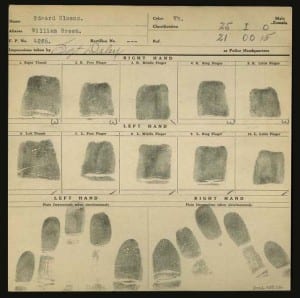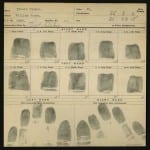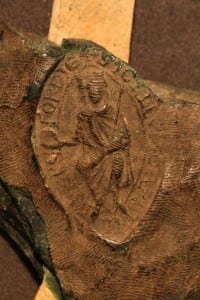To find out more about what we’re up to, watch this video.
Category: Introduction
Fingerprinting as an Identity Science: A History
As part of Aberystwyth University’s work placement scheme, AberForward, I was lucky enough to be placed under the direct supervision of Aberystwyth’s very own Lady of the Seals, Dr Elizabeth New, and work on the Imprint Project. I was incredibly excited to work on such an amazing project, although it did cause confusion with my friends and family back home when I told them that I was working on a project about medieval seals. (Surprisingly, a few thought I meant the mammal and were somewhat perplexed as to how medieval seals were different to their modern counterparts, let alone be able to work with a seal so old.)
A majority of the work I undertook was researching the origins and developments of identity science and fingerprinting. My goodness, it was fascinating! Shrouded with issues of race, the fear of the unknown, and even bickering ‘discoverers’, the development of using fingerprints for identification is definitely an interesting tale. Prior to the project, I had absolutely no idea how diverse its history is. I merely expected that fingerprints had been left at a crime scene one day and that the police inspector at the time had the bright idea to take all the suspects fingerprints and voilà! Fingerprinting had been invented. This was definitely not the case. It took roughly about a century to create a viable system which could efficiently deal with masses of information. For years, being able to identify people through their fingerprints was simply a dream and totally unrealistic. Thanks to the work of many including Sir William Herschel, Henry Faulds, Francis Galton, Juan Vucetich and Sir Edward Henry, the dream has become the reality.
Humans have always had a knowledge of fingerprints. It is nothing new. In Asia, Europe and North America there are cave paintings which feature fingerprints possibly showing authorship and/or identity. In China there has been evidence of fingerprint impressions in clay which were then used for official documents. The archaeological evidence found can be dated to the 7th Century but additional evidence suggests that this practice occurred earlier, during the time of the Han Dynasty (220 BCE – 202 BCE- so to put this in context, Rome was not even an empire at this period.) In the Holy Roman Empire during the medieval period, wax seals bore deep fingerprints, usually three in a line.
Prior to fingerprint identification, identity science was pretty limited. In a world changed by the industrial revolutions, many people were moving from the countryside to the city as well as moving up and down the social class scale. This made it very difficult to identify people based on who knew who and it became a society of strangers. It became increasingly important to identify those with a criminal record, since brandings had gone out of fashion, and society feared the ‘habitual criminal’, i.e. those believed to have been born to be a criminal and create mass havoc for the law-abiding citizens. At first, body marks (such as moles, birthmarks, freckles and scars) were used as the primary identifiers. However, it was quickly realised that it was quite easy to misidentify people as human memory is surprisingly rather terrible at actually remembering things. For example in Bangor, Maine, USA, in 1849 the parents of Luther Hause misidentified a man who they believed to be their son as the imposter was able to show scars on his knee, chest and neck which were what the Hauses could remember about their son.
Ideas to identify people could be pretty strange. For example, the use of phrenology (the deduction of personality and characteristics from the lumps and bumps of the skull which were supposedly responsible for specific character traits) and scent prints were both legitimate suggestions.
Alphonse Bertillon did create a system in the late 19th Century which was quickly adopted around the world. His system involved eleven precise measurements of the individual. Some of the measurements he took included the height, the head breadth, the left little finger, cheek width and left foot length chosen for their ability to not change due to weight. The coded descriptions, which involved vast amounts of information of the individual, were taken and included alongside the measurements with two photos on ‘Bertillon’ cards.

From www.nleomf.org
Fingerprinting was developed around the same time and became the accepted system of identification at the turn of the century. Bertillon’s measurement system was simply too complex and required considerable training, which many police departments had neither the time nor the money for. Bertillon required a level of exact precision which a lot of ‘Identification clerks’ did not bother to adhere to. They would often measure in imperial unit rather than metric (which Bertillon required for precision) so measurements changed from country to country thus creating inconsistencies. (The stereotype for Napoleon being a short angry man is completely false. Angry yes, short no. The French inch was much bigger than its English equivalent.) Fingerprinting required painting the individual’s fingers and thumbs with a special ink designed to make fingerprints more visible. They were pressed onto paper, and then sent to a specialist. Ta-dah! The individual was now in the system. The main problem was creating a viable system which could easily identify a set of fingerprints from a figurative ocean of millions.
The systems for fingerprinting were created in India and Argentina in the late 19th Century. At the time, the British officials were convinced that the Indians were prone to committing fraud (fraud was seen as the worst crime), and also believed that it was impossible to tell them apart, so it was possible they were pretending to be a dead person. In Argentina, crime and mass immigration were the main problems, because officials did not know whether the new immigrants were ‘habitual criminals’. In the late 19th century, Bertillonage was seen as the most sophisticated system whereas fingerprinting was deemed only suitable for the colonies because there were no natives who had the necessary skills for Bertillonage. (Racism was pretty normal back then.) Galton was the first to develop the system. He based his 3-point identification system on the work collected by Sir William J. Herschel, whose collection began in 1857 when he aggressively forced a building supplier to place his handprint on the back of a contract to avoid being swindled. Unfortunately, his system was not actually viable but luckily he inspired others. Vucetich and Henry both developed their systems from Galton’s and they both managed to create a fully functioning system which could cope with large amounts of data. This meant that it was finally possible to identify a person through a biological presence which was fairly unique for each individual.
I have thoroughly enjoyed my time working for the Imprint Project team. The work I have completed has been so fascinating that I will now be able to bore my friends and family silly from all the facts that I’ve learnt. My favourite aspect was being able to learn new and interesting facts about a period I am rather unfamiliar with, without the pressure of completing an exam at the end of it! I had quite forgotten the thrill of learning history for history’s sake. I will definitely be keeping up-to-date with the project and I would like to thank Dr Elizabeth New for allowing me to be part of it all!
Bethany Dale
Links and resources:
Simon A. Cole. Suspect Identities: A History of Fingerprinting and Criminal Identification. Cambridge, Massachusetts: Harvard University Press, 2002.
The History of Fingerprinting
Crime Scene Forensics, LLC
Charters and seals and blogs, oh my!
Welcome to the Imprint Project blog! We have been running around all over the place (National Library of Wales, Hereford Cathedral Archives and Exeter Cathedral Archives) and we are soon to move on to Westminster Abbey. We’ve looked at hundreds of seals, imaged hundreds of prints and also had the chance to use our Crime-Lite Imager to look at some treasures. More details to follow, so watch this space!

